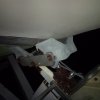docmirror
Touchdown! Greaser!
- Joined
- Jan 5, 2007
- Messages
- 12,008
- Display Name
Display name:
Cowboy - yeehah!
http://www.amazon.com/SeaSense-Trailer-Guide-Pole-Only/dp/B004XAH9F2
Sounds like no fatalities. That's always good. These things are very useful in windy conditions. Also helpful when you are doing it yourself.
For the rollers, you can make a metal shim for the frame where the axle rides on the brace(you know what I mean when you look down there. This will keep the rollers in the right pitch for the boat to roll up on. Takes an hour or so to make. Mark the roller location with the boat on, then make the shim and install the next time you go to the lake and have the boat off the trailer. Take new bolts and nuts for the roller axle because they often are corroded and snap when removed. Some have a stainless axle with a clevis pin and a few washers, just pull the clevis and the axle and make an angled shim then put the shim under the brace and onto the axle to keep it in place.
<edit: for when you go out over the weekend(and you will soon), I've owned one of these for 23 years, and it's got a ton of use on it. It's cast Al, which makes it surprisingly light, it folds up to carry really easy, and has a built in stand. It'll cook a ton of stuff for 4 folks. I've had everything from steak, to pork, cans, and of course lots of fish grilled over the years. http://www.amazon.com/Camco-57301-O...12325&sr=1-12&keywords=portable+propane+grill >
Sounds like no fatalities. That's always good. These things are very useful in windy conditions. Also helpful when you are doing it yourself.
For the rollers, you can make a metal shim for the frame where the axle rides on the brace(you know what I mean when you look down there. This will keep the rollers in the right pitch for the boat to roll up on. Takes an hour or so to make. Mark the roller location with the boat on, then make the shim and install the next time you go to the lake and have the boat off the trailer. Take new bolts and nuts for the roller axle because they often are corroded and snap when removed. Some have a stainless axle with a clevis pin and a few washers, just pull the clevis and the axle and make an angled shim then put the shim under the brace and onto the axle to keep it in place.
<edit: for when you go out over the weekend(and you will soon), I've owned one of these for 23 years, and it's got a ton of use on it. It's cast Al, which makes it surprisingly light, it folds up to carry really easy, and has a built in stand. It'll cook a ton of stuff for 4 folks. I've had everything from steak, to pork, cans, and of course lots of fish grilled over the years. http://www.amazon.com/Camco-57301-O...12325&sr=1-12&keywords=portable+propane+grill >
Last edited:







